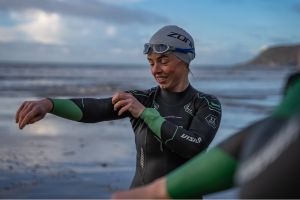Acclimatising and understanding cold water
Written by Chloe Rafferty, Director of Love SwimRun and STA Open Water Swimming Coach.
The first thing you can do to help prepare your body for cold water is to take cold showers or baths to get used to the sensation of cold shock. The first dousing in cold water will be a physical and psychological shock but once your body is acclimatised this response is dulled.
The best way to acclimatise to cold water is just to expose yourself to it often, at least once a week, and preferably more, gradually extending the time that you stay in the water (being mindful of the other points in this article). Ideally it is best to start your swimming in summer when the water temperature is warmer, and then keep on swimming through the autumn and then winter as the temperature drops but that does not mean you cannot start now.

Understanding Cold Shock
When you get into cold water your body will experience the Cold Shock Response – the cold water causes blood vessels in the skin to contract, which forces your heart to work harder to deliver oxygen to your major organs and muscle. Heart rate is increased and your blood pressure goes up. Cold water shock can cause heart attacks. If you have a heart condition (or family history of heart conditions) or asthma, seek advice from your GP before attempting cold water swims.
The sudden cooling of the skin also causes an involuntary gasp for breath. Breathing rates increase rapidly, which contributes to a feeling of panic. This effect can last for up to about 3 minutes. Try to relax and let your body accept the cold. You will be breathing in sharply but try to concentrate on breathing out slowly. The good news is that it is possible to train and become accustomed to Cold Shock Response quite quickly. After doing about 5 or 6 two to three minute cold water swims where the whole body (but not the head) is immersed, you should be able to halve your Cold Shock Response!
Wetsuits do not completely remove the cold shock response when you get in as the cold water will quickly seep inside the suit. The wearer will still experience the Cold Shock response so the same care should be taken when entering the water. After a short while however the benefit of the neoprene kicks in and the layer of water trapped between the skin and the wetsuit warms up to help provide insulation against the cold.
Never jump or dive into cold water. Get in gradually, pausing for a moment once or twice to allow your submerged skin to adjust to the temperature of the water. Do not go out of your depth until the initial cold shock response has passed. As you wade in you can splash water onto your upper body and face to begin to get used to the temperature. Once you are in to your shoulders, dip your face in the water a few times before you start swimming properly. Once swimming, try to keep moving and concentrate on keeping your breathing steady.
How physiology affects your ability to swim in cold water
Your body shape and size will have an effect on how you cope with cold water submersion. The fat on our bodies, particularly the subcutaneous fat that sits underneath the skin, offers insulation, so the more you have the more insulated you will be! The ratio between weight and body surface area is also important, so if you’re short and heavy (have a lot of fat), you’ll likely cope with swimming in cold water better because you’ve got a high body mass to body surface area ratio. Taller, slimmer people lose heat more rapidly as they have a large surface area where they can loose heat and not much natural insulation.
Keep your eye out for part 3 - The effects of cold water on your body














 Creating world class triathlon kit since 2006
Creating world class triathlon kit since 2006
 Free delivery on orders over £75, next day available
Free delivery on orders over £75, next day available
 Fast and Free returns
Fast and Free returns
 Rated excellent 4.5 out of 5 from over 3,500+ reviews
Rated excellent 4.5 out of 5 from over 3,500+ reviews









